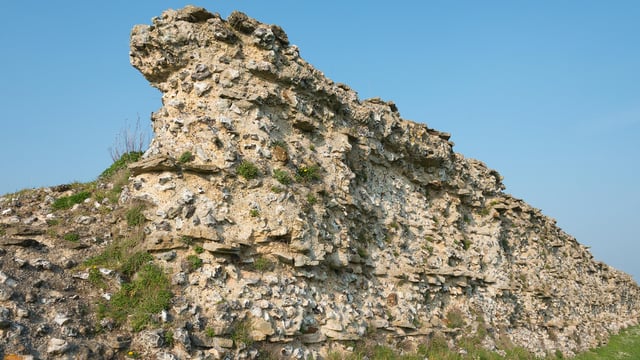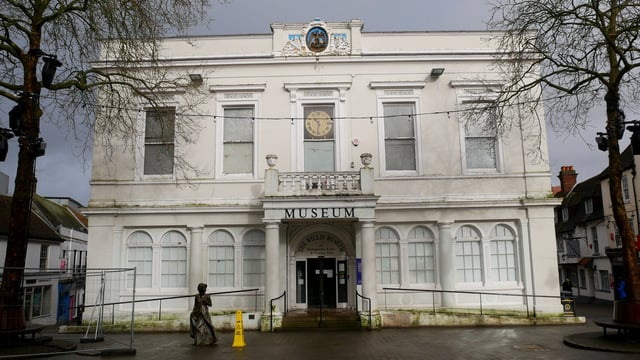- Ethan Doyle White
- Last Checked and/or Updated 10 January 2024
- No Comments
- Exhibitions, Reviews
You may not have heard of Sorbiodunum, Verulamium, or Camulodunum, but – if you live in England at least – chances are that you’re more familiar with Salisbury, St Albans, and Colchester. Just like London, many of England’s towns and cities stand upon the ruins of their Roman predecessors, offering us a tangible reminder of how the Roman Empire is still with us today.
Of course, not every Romano-British settlement lives on. Calleva Atrebatum was once an important town at a Roman crossroads, but today survives largely in the form of its ruined protective walls. It’s often referred to as Silchester, but that is more properly the name of a village just to the west of the Roman settlement, located about 5 miles from Basingstoke in north Hampshire.

Calleva Atrebatum was already an important place at the time of the Roman conquest. In the Late Iron Age it was the capital of the Atrebates, a people whose origins lay, at least in part, over the English Channel in Gaul. Under Roman rule, the settlement was reorganised on a grid pattern and gained luxury amenities such as a bathhouse and amphitheatre, serving as a centre for local taxation and the production of various goods.
Archaeologists launched excavations of Calleva Atrebatum in the late 19th century, with more modern investigations taking place under the aegis of Reading University since the 1970s. Over the decades, Reading archaeologists have amassed thousands of finds from the site, a small fraction of which are now showcased at a small exhibition, Becoming Roman – Silchester, a Town of Change. I visited while they were setting up to get an early insight into what you can expect.
“Becoming Roman – Silchester, a Town of Change contains so many objects that give us a frozen moment in time; from a footprint on a drying floor tile to hairpins lost in the Roman baths and coins dropped in the forum. These little, everyday occurrences and misfortunes allow us to connect emotionally with the daily life someone living thousands of years ago.”
Nick Suffolk, Head of Heritage Experience at Hampshire Cultural Trust
What to Expect?

Now on at the Willis Museum in Basingstoke, the exhibition brings together a selection of around 150 artefacts. For many, this will be the first time they appear in a public exhibition. Perhaps the most impressive is a large ceramic storage vessel, charred from its later reuse as an oven, that conservationists have carefully pieced together from broken sherds.
Other interesting displays include the skeletons of two dogs, one a small, chihuahua-sized lap dog that – thanks to strontium analysis – we now know originally came from continental Europe. Given the care and purpose with which the dog was buried, archaeologists re certain that the dog belonged to a wealthy individual, and probably someone with high status in the community. The second is a larger canine which, given the injuries on its bones, clearly suffered a much harder life, perhaps used for blood sports or as a guard dog.

Many of the small finds provide an insight into daily life for Silchester’s Roman residents, from brooches and intaglios through to keys and writing styli. Other artefacts shine light on the religious worlds of the settlement’s inhabitants. I was particularly interested by a Neolithic polished stone axe and a young woman’s jawbone, both artefacts carefully collated and buried as a foundation deposit beneath one of Silchester’s buildings, giving us a glimpse into the way that Romano-Britons themselves engaged with the past on a spiritual level.
Bringing us further into the present, the exhibition also includes a selection of objects left behind by the site’s late Victorian excavators, including glass bottles, an inkwell, and a broken tea cup.
Although I visited before the exhibition was fully set up, there are several activities aimed to help keep younger visitors entertained. These include a mosaic repair, a Roman measuring game, animal print tracking and a healing cure.


Planning Your Visit
Becoming Roman – Silchester, a Town of Change is on at Basingstoke’s Willis Museum until 27 April 2024. Entry is free, although donations are welcome. The museum is only a ten minute walk from Basingstoke railway station, which offers routes back and forth from London Waterloo.
Although Basingstoke is hardly a big town, I fleshed out my visit to the museum with a perusal of both the ruined 16th-century Chapel of the Holy Trinity and the medieval Church of Saint Michael (unfortunately the latter was closed at the time). Both are in easy walking distance from the museum and station, although several sets of outdoor stairs may pose challenges for those with mobility issues. The front entrance to the museum does have a ramp for wheelchair access.
Visitors coming to Basingstoke by car could also combine their visit to Willis Museum with a trip to the ruins of Silchester itself, an English Heritage site now free to visit.
After completing its time at Willis Museum, the Silchester exhibition will move on to the Red House Museum in Christchurch, Andover Museum, Reading Museum, and Reading University Library.
Further details about the exhibition and visiting the Willis Museum and Sainsbury Gallery can be found on the Official Exhibition Website.
Professor Michael Fulford of the University of Reading
Add Silchester to Your Itineraries & Travel Lists
Using our itinerary builder, you can create your own travel lists (such as places you have been to, places you would like to visit) and itineraries. These can also be shared with your friends and on social media. You can see how this is done by watching our Using the Itinerary video on YouTube, or reading the Using the Itinerary page.
Roman Silchester – Calleva Atrebatum
The completely buried remains of the Roman town of Calleva Atrebatum, near present day Silchester, are still surrounded by what are considered to be some of the best preserved Roman town walls in England. Originally an Iron Age oppidum, the settlement was first occupied by Romans in about 45 AD and then abandoned by the 5th century. Outside the polygonal walls a relatively well preserved, albeit overgrown with trees and shrubbery, amphitheatre can be visited. There is a car park at St Mary’s church, from where it is easy to visit the amphitheatre and see the walls.


Willis Museum & Sainsbury Gallery
In a building and location rich in history, visitors can learn more about the history of Basingstoke and surrounding area. The Archaeology Galley has exhibits spanning a period from the Stone Age to Saxon England, and includes a mammoth tusk and artefacts from Roman Silchester. The story of Basingstoke covers the medieval to post War period – on display is a 1950s kitchen and what is said to be the world’s oldest wedding cake, having been created in 1898 it is now well over a hundred years old.






